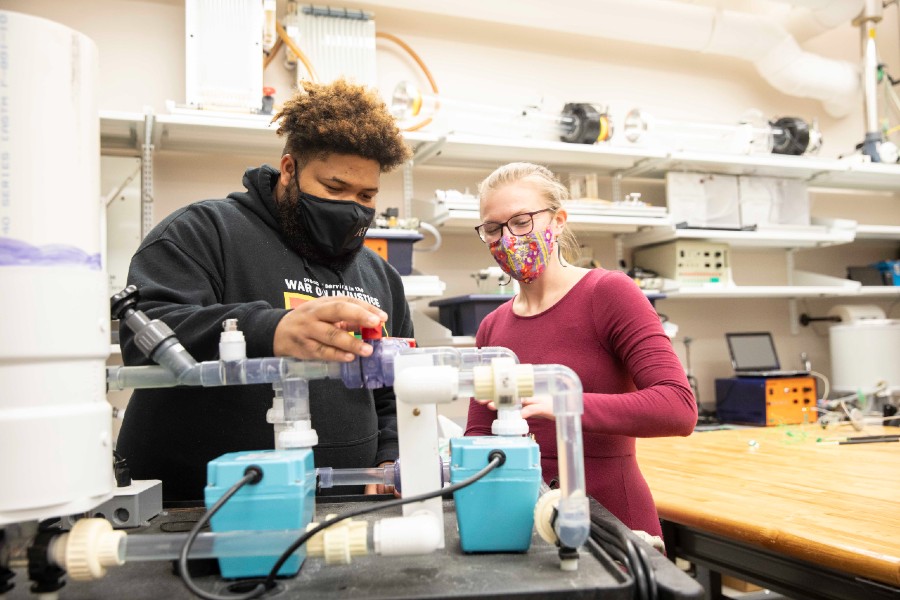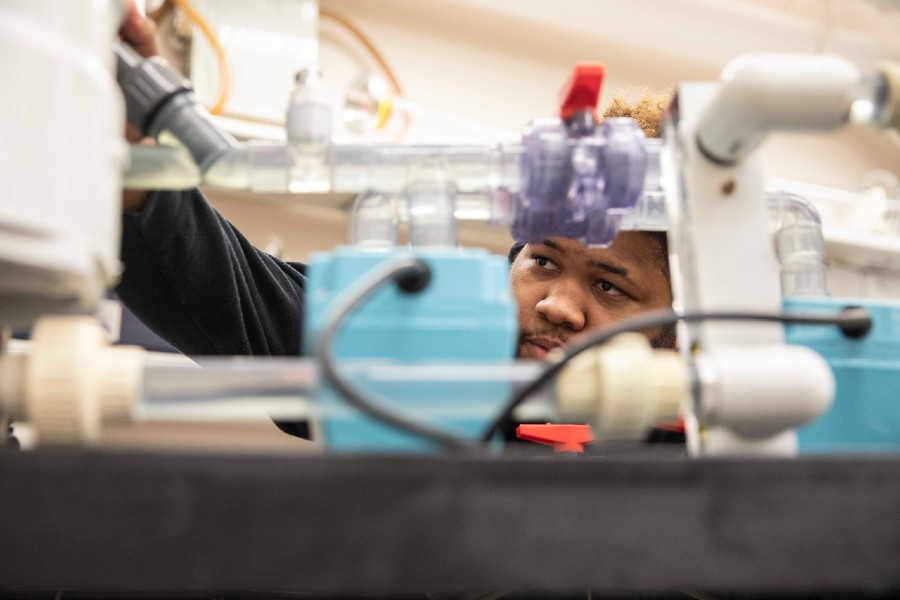College establishes diversity and inclusion task force in August
Students, faculty and staff to use engineering design to create a more inclusive atmosphere.
Janel Shoun-Smith | 615.966.7078 |

Civil engineering student Trey Phillips works with Assistant Professor Kirsten Dodson, who is one of the coordinators of the college's task force on diversity and inclusion.
This summer, the Raymond B. Jones College of Engineering kick-started an effort to use engineering design concepts within its structure to ensure that all students receive an equitable engineering education, with the ultimate goal of enhancing diversity within the engineering field itself.
Interested faculty, staff and students were invited to join a diversity, equity and inclusion task force that plans to meet bi-weekly throughout the 2020-2021 school year to enact change throughout the college.
Recruitment for the task force was launched with a two-hour session at the college’s opening faculty retreat, where college Dean David Elrod ('77), engineering faculty member Kirsten Dodson (’12), and William Turner, special counsel to the president for diversity and inclusion, presented an overview of diversity and inclusion needs and concerns for enhancing training contexts for engineers.
The process the college will use is borrowed from Dr. Yvette E. Pearson, a well-known professional engineer and engineering educator who advocates applying the same design process engineers use to create a more inclusive environment. She lays out her arguments for the approach in a podcast called Engineering Change.
The engineering design process encompasses a strategic use of brainstorming, research, prototyping, testing and other steps to complete a successful and efficient design, said Dodson, who is working with Elrod to launch the task force.
“As I read the Bible, I see Christ as giving His life to reconcile all people to Himself. Given that sacrifice, it breaks my heart to see so much of the news in recent months focused on what I consider to be the opposite of reconciliation—division, racism and partisanship,” said Elrod.
“I value the opportunity to participate in a forum where interested faculty and students can deal with tough issues in a way that makes us stronger by helping us leverage the diversity with which God entrusted us.”

The college is using engineering design concepts to ensure that all students receive an equitable engineering education.
Throughout this school year, the task force will move through various strategic steps including:
- Recognizing gaps with respect to equity and inclusion in the engineering college;
- Reflecting on personal experiences and implicit biases as a group for a learned and meaningful team dynamic;
- Creating goals and objectives for envisioning change within the engineering college;
- Examining the culture, policies and strategies of the college to find room for improvement;
- Understanding the problems through research, interviews, and observations with stakeholders of the college;
- Building action plans for implementing change initiatives within the college;
- Prioritizing intentional solutions that will create high levels of positive impact within the college;
- Piloting the initiatives and receiving feedback from stakeholders to iterate upon and finalize initiatives;
- Implementing the finalized initiatives intentionally and gradually in the college; and
- Planning for long-term monitoring and evaluation of the initiatives to determine if goals were met and what other actions should be taken.
So far, the task force, composed of five faculty and nine student representatives, has defined mission and vision statements, completed a stakeholder analysis and researched existing efforts as well as related literature on the topic. Along the way, the members are investigating their own implicit biases and reflecting on how current events are impacting engineering students.
Future tasks include developing a survey to gain better insight into student views about the college's diversity, equity and inclusion efforts and utilizing the responses as they design and implement solutions.
“As a female in the engineering field, I can see that there is a clear need for change toward more inclusivity in the industry,” Dodson said. “We have heard from students of different backgrounds that they want change as well. We can’t change the whole field, but we know we can do something here at Lipscomb. Our students are excited about doing something actionable here in our college.”